2017 HONDA CLARITY FUEL CELL tow
[x] Cancel search: towPage 4 of 527
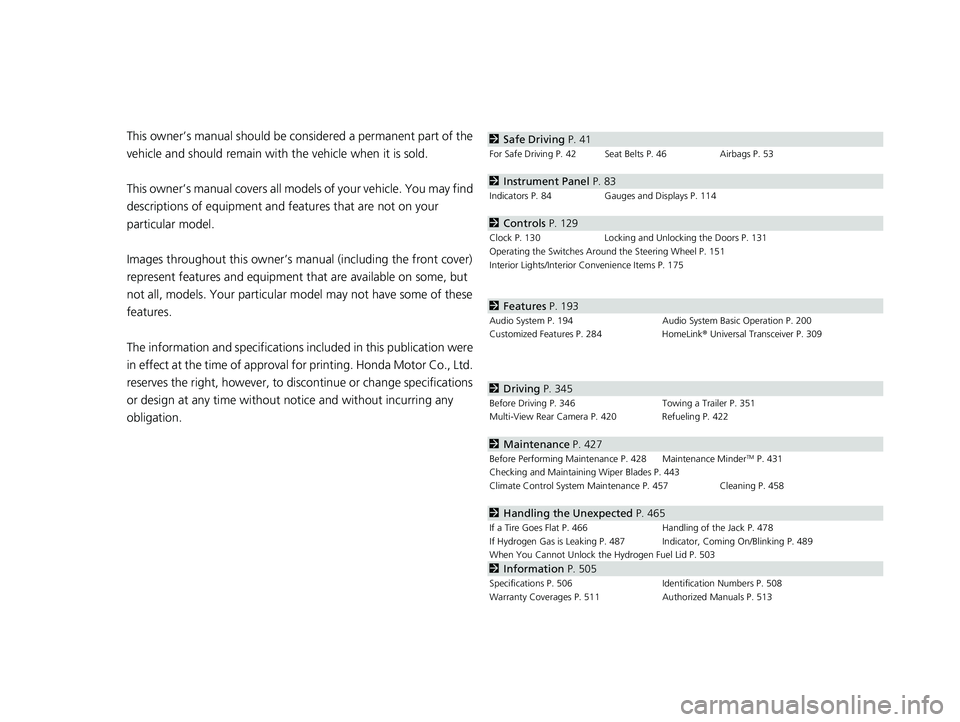
Contents
This owner’s manual should be considered a permanent part of the
vehicle and should remain with the vehicle when it is sold.
This owner’s manual covers all models of your vehicle. You may find
descriptions of equipment and features that are not on your
particular model.
Images throughout this owner’s manu al (including the front cover)
represent features and equipment that are available on some, but
not all, models. Your particular mo del may not have some of these
features.
The information and specifications in cluded in this publication were
in effect at the time of approval for printing. Honda Motor Co., Ltd.
reserves the right, however, to discontinue or change specifications
or design at any time without notice and without incurring any
obligation.2 Safe Driving P. 41
For Safe Driving P. 42 Seat Belts P. 46 Airbags P. 53
2Instrument Panel P. 83
Indicators P. 84 Gauges and Displays P. 114
2Controls P. 129
Clock P. 130 Locking and Unlocking the Doors P. 131
Operating the Switches Ar ound the Steering Wheel P. 151
Interior Lights/Interior Convenience Items P. 175
2 Features P. 193
Audio System P. 194 Audio System Basic Operation P. 200
Customized Features P. 284 HomeLink® Universal Transceiver P. 309
2 Driving P. 345
Before Driving P. 346 Towing a Trailer P. 351
Multi-View Rear Camera P. 420 Refueling P. 422
2 Maintenance P. 427
Before Performing Maintenance P. 428 Maintenance MinderTM P. 431
Checking and Maintaining Wiper Blades P. 443
Climate Control System Main tenance P. 457 Cleaning P. 458
2Handling the Unexpected P. 465
If a Tire Goes Flat P. 466 Handling of the Jack P. 478
If Hydrogen Gas is Leaking P. 487 Indicator, Coming On/Blinking P. 489
When You Cannot Unlock the Hydrogen Fuel Lid P. 503
2 Information P. 505
Specifications P. 506 Identification Numbers P. 508
Warranty Coverages P. 511 Authorized Manuals P. 513
17 CLARITY FCV PPO-31TRT6000.book 2 ページ 2016年10月27日 木曜日 午後3時11分
Page 5 of 527
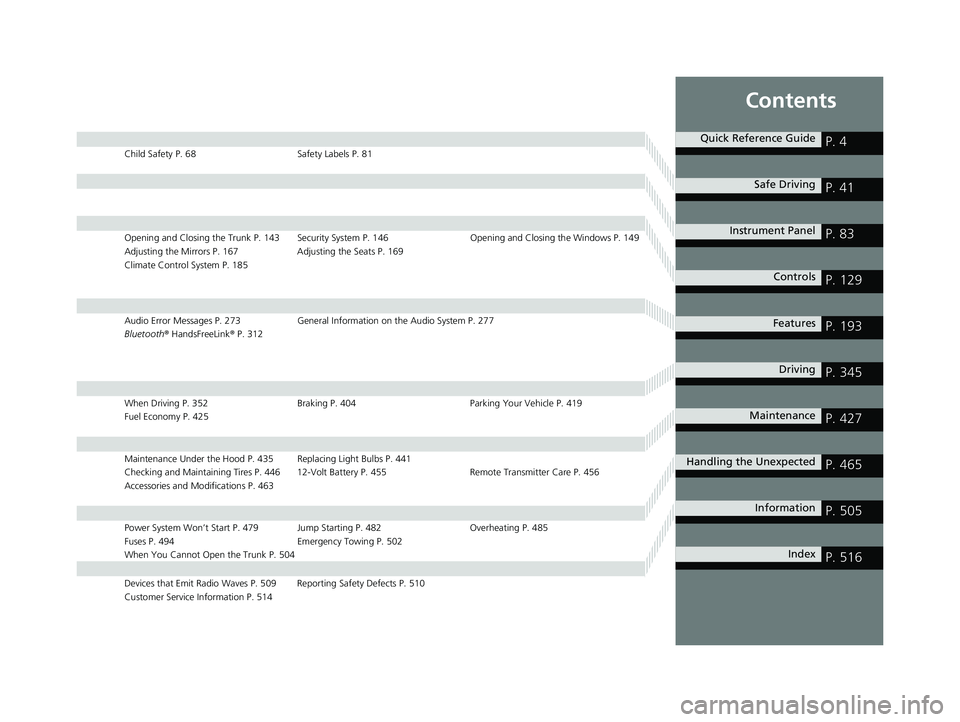
Contents
Child Safety P. 68Safety Labels P. 81
Opening and Closing the Trunk P. 143 Security System P. 146 Opening and Closing the Windows P. 149
Adjusting the Mirrors P. 167 Adjusting the Seats P. 169
Climate Control System P. 185
Audio Error Messages P. 273 General Information on the Audio System P. 277
Bluetooth® HandsFreeLink ® P. 312
When Driving P. 352 Braking P. 404Parking Your Vehicle P. 419
Fuel Economy P. 425
Maintenance Under the Hood P. 435 Replacing Light Bulbs P. 441
Checking and Maintaining Tires P. 446 12-Volt Battery P. 455 Remote Transmitter Care P. 456
Accessories and Modifications P. 463
Power System Won’t Start P. 479 Jump Starting P. 482 Overheating P. 485
Fuses P. 494 Emergency Towing P. 502
When You Cannot Open the Trunk P. 504
Devices that Emit Radio Waves P. 509 Reporting Safety Defects P. 510
Customer Service Information P. 514
Quick Reference GuideP. 4
Safe DrivingP. 41
Instrument PanelP. 83
ControlsP. 129
FeaturesP. 193
DrivingP. 345
MaintenanceP. 427
Handling the UnexpectedP. 465
InformationP. 505
IndexP. 516
17 CLARITY FCV PPO-31TRT6000.book 3 ページ 2016年10月27日 木曜日 午後3時11分
Page 18 of 527

16
Quick Reference Guide
Hydrogen Gas Leak
If a hydrogen gas leak is suspected, follow the recommended actions listed in the
instructions of this owner’s manual. 2 If Hydrogen Gas is Leaking (P487)
WARNING
Since hydrogen gas is highly flammable, a
hydrogen gas leak is extremely dangerous
as the leaked gas, which is dispersed into
the atmosphere, can ignite, resulting in a
fire in which you or someone else can be
serious injured or killed. Keep flammable
materials and liquids away from the vehicle
at all times, especially if a hydrogen gas
leak is detected.
In the case of a hydrogen gas leak, a buzzer
will sound and the hydrogen gas leak
indicator will come on. If you are driving
the vehicle, stop in a safe, well-ventilated
place. Then turn the power mode to OFF
and contact an authorized Honda Clarity
Fuel Cell dealer at once. You should also
display signs warning of the danger and be
aware of and keep away anything that
could ignite the gas.
The system is designed so that in the event
that the vehicle catches fire, the gas inside
the tanks will be released through the tank
valves, thereby ensuring that pressure (due
to heat from the fire) within the tanks does
not build up.
This gas is released toward the rear of the
vehicle in a downward direction. Do not
attempt to extinguish the fire from behind
the vehicle as the exiting gas may ignite
into a flame.
17 CLARITY FCV PPO-31TRT6000.book 16 ページ 2016年10月27日 木曜日 午後3時 11分
Page 21 of 527
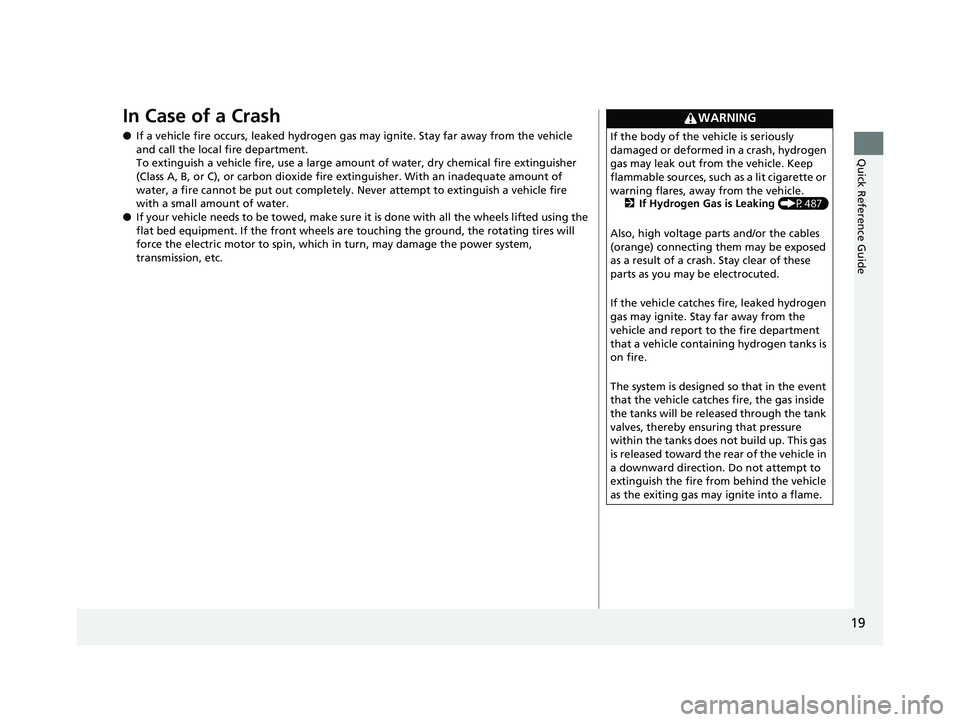
19
Quick Reference Guide
In Case of a Crash
●If a vehicle fire occurs, leaked hydrogen gas may ignite. Stay far away from the vehicle
and call the local fire department.
To extinguish a vehicle fire, use a large amount of water, dry chemical fire extinguisher
(Class A, B, or C), or carbon dioxide fire extinguisher. With an inadequate amount of
water, a fire cannot be put out completely. Never attempt to extinguish a vehicle fire
with a small amount of water.
● If your vehicle needs to be towed, make sure it is done with all the wheels lifted using the
flat bed equipment. If the front wheels are touching the ground, the rotating tires will
force the electric motor to spin, which in turn, may damage the power system,
transmission, etc.
WARNING
If the body of the vehicle is seriously
damaged or deformed in a crash, hydrogen
gas may leak out from the vehicle. Keep
flammable sources, such as a lit cigarette or
warning flares, away from the vehicle. 2If Hydrogen Gas is Leaking (P487)
Also, high voltage parts and/or the cables
(orange) connecting them may be exposed
as a result of a crash. Stay clear of these
parts as you may be electrocuted.
If the vehicle catches fire, leaked hydrogen
gas may ignite. Stay far away from the
vehicle and report to the fire department
that a vehicle containing hydrogen tanks is
on fire.
The system is designed so that in the event
that the vehicle catches fire, the gas inside
the tanks will be released through the tank
valves, thereby ensuring that pressure
within the tanks does not build up. This gas
is released toward the rear of the vehicle in
a downward direction. Do not attempt to
extinguish the fire from behind the vehicle
as the exiting gas may ignite into a flame.
17 CLARITY FCV PPO-31TRT6000.book 19 ページ 2016年10月27日 木曜日 午後3時 11分
Page 28 of 527
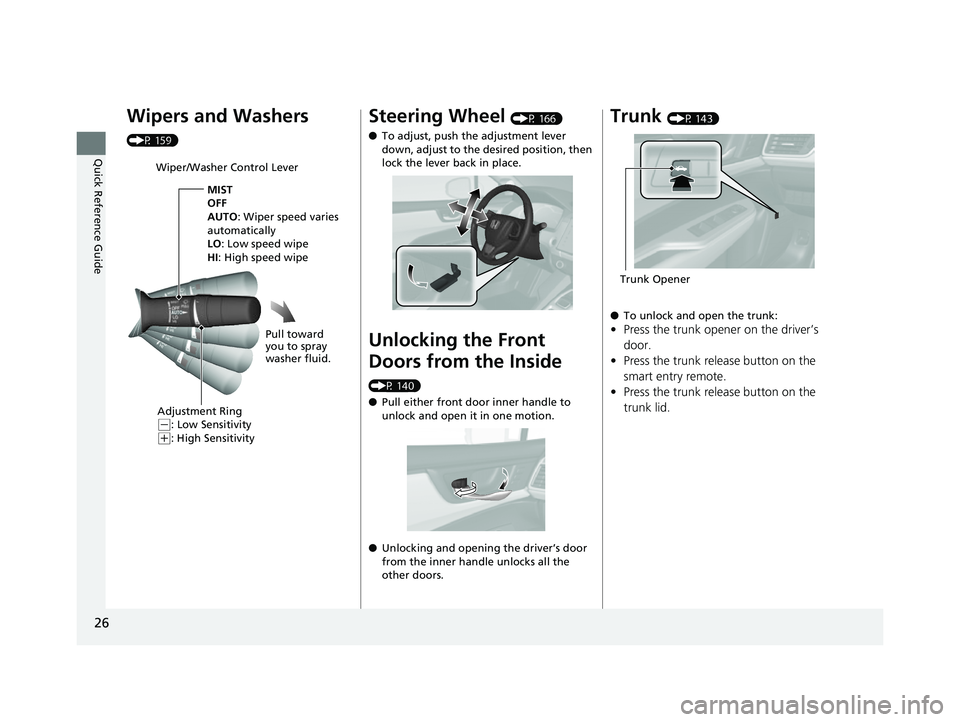
26
Quick Reference Guide
Wipers and Washers
(P 159)
Wiper/Washer Control LeverAdjustment Ring
(-: Low Sensitivity
(+: High Sensitivity MIST
OFF
AUTO
: Wiper speed varies
automatically
LO: Low speed wipe
HI: High speed wipe
Pull toward
you to spray
washer fluid.
Steering Wheel (P 166)
● To adjust, push the adjustment lever
down, adjust to the desired position, then
lock the lever back in place.
Unlocking the Front
Doors from the Inside
(P 140)
●Pull either front door inner handle to
unlock and open it in one motion.
● Unlocking and opening the driver’s door
from the inner handle unlocks all the
other doors.
Trunk (P 143)
● To unlock and open the trunk:
•Press the trunk opener on the driver’s
door.
• Press the trunk release button on the
smart entry remote.
• Press the trunk release button on the
trunk lid.
Trunk Opener
17 CLARITY FCV PPO-31TRT6000.book 26 ページ 2016年10月27日 木曜日 午後3時 11分
Page 38 of 527

36
Quick Reference Guide
Handling the Unexpected (P 465)
Flat Tire (P 466)
● Park in a safe location and repair the flat
tire using the temporary tire repair kit.
Indicators Come On
(P 489)
●Identify the indicator and consult the
owner’s manual.
Power System Won’t Start
(P 479)
● If the 12-volt battery is dead, jump start
using a booster battery.
Blown Fuse
(P 494)
● Check for a blown fuse if an electrical
device does not operate.
Overheating (P 485)
● Park in a safe location. If you do not see
steam under the hood, open the hood,
and let the power system cool down.
Emergency Towing
(P 502)
●Call a professional towing service if you
need to tow your vehicle.
17 CLARITY FCV PPO-31TRT6000.book 36 ページ 2016年10月27日 木曜日 午後3時 11分
Page 60 of 527
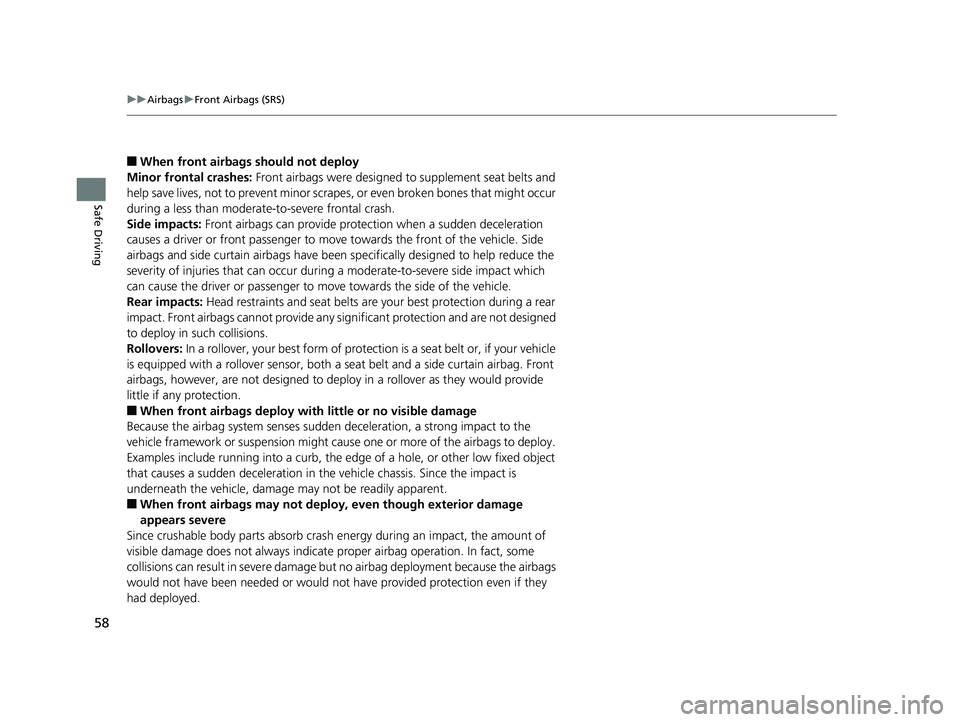
58
uuAirbags uFront Airbags (SRS)
Safe Driving
■When front airbags should not deploy
Minor frontal crashes: Front airbags were designed to supplement seat belts and
help save lives, not to prevent minor scrapes, or even broken bones that might occur
during a less than moderate-to-severe frontal crash.
Side impacts: Front airbags can provide protection when a sudden deceleration
causes a driver or front passenger to move towards the front of the vehicle. Side
airbags and side curtain airbag s have been specifically designed to help reduce the
severity of injuries that can occur durin g a moderate-to-severe side impact which
can cause the driver or passenger to move towards the side of the vehicle.
Rear impacts: Head restraints and seat belts are your best protection during a rear
impact. Front airbags cannot provide any si gnificant protection and are not designed
to deploy in such collisions.
Rollovers: In a rollover, your best form of protection is a seat belt or, if your vehicle
is equipped with a rollover sensor, both a se at belt and a side curtain airbag. Front
airbags, however, are not designed to deploy in a rollover as they would provide
little if any protection.
■When front airbags deploy with little or no visible damage
Because the airbag system senses sudden deceleration, a strong impact to the
vehicle framework or suspension might caus e one or more of the airbags to deploy.
Examples include running into a curb, the edge of a hole, or other low fixed object
that causes a sudden deceleration in th e vehicle chassis. Since the impact is
underneath the vehicle, damage may not be readily apparent.
■When front airbags may not deploy, even though exterior damage
appears severe
Since crushable body parts absorb crash energy during an impact, the amount of
visible damage does not always indicate proper airbag operation. In fact, some
collisions can result in severe damage but no airbag deployment because the airbags
would not have been needed or would not have provided protection even if they
had deployed.
17 CLARITY FCV PPO-31TRT6000.book 58 ページ 2016年10月27日 木曜日 午後3時 11分
Page 61 of 527
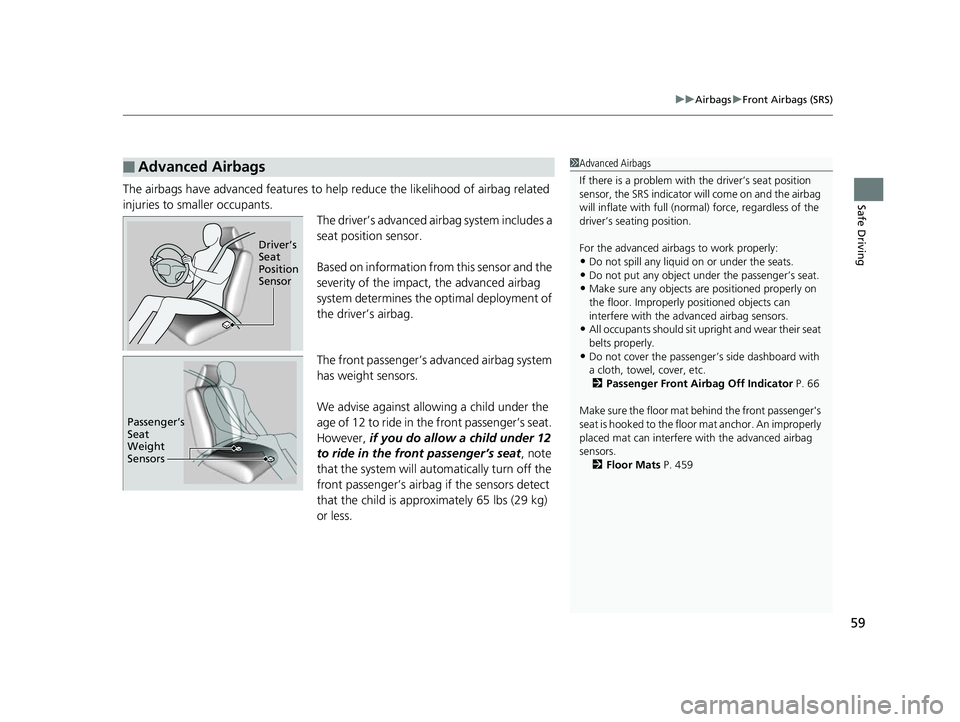
59
uuAirbags uFront Airbags (SRS)
Safe DrivingThe airbags have advanced features to help reduce the likelihood of airbag related
injuries to smaller occupants. The driver’s advanced airbag system includes a
seat position sensor.
Based on information from this sensor and the
severity of the impact, the advanced airbag
system determines the optimal deployment of
the driver’s airbag.
The front passenger’s ad vanced airbag system
has weight sensors.
We advise against allowing a child under the
age of 12 to ride in the front passenger’s seat.
However, if you do allow a child under 12
to ride in the front passenger’s seat , note
that the system will auto matically turn off the
front passenger’s airbag if the sensors detect
that the child is approximately 65 lbs (29 kg)
or less.
■Advanced Airbags1 Advanced Airbags
If there is a problem with the driver’s seat position
sensor, the SRS indicator wi ll come on and the airbag
will inflate with full (normal) force, regardless of the
driver’s seating position.
For the advanced airbags to work properly:
•Do not spill any liquid on or under the seats.•Do not put any object under the passenger’s seat.
•Make sure any objects are positioned properly on
the floor. Improperly pos itioned objects can
interfere with the advanced airbag sensors.
•All occupants should sit upri ght and wear their seat
belts properly.
•Do not cover the passenger ’s side dashboard with
a cloth, towel, cover, etc. 2 Passenger Front Airbag Off Indicator P. 66
Make sure the floor mat behind the front passenger's
seat is hooked to the floor mat anchor. An improperly
placed mat can interfere with the advanced airbag
sensors. 2 Floor Mats P. 459
Driver’s
Seat
Position
Sensor
Passenger’s
Seat
Weight
Sensors
17 CLARITY FCV PPO-31TRT6000.book 59 ページ 2016年10月27日 木曜日 午後3時 11分